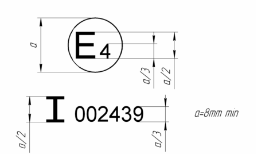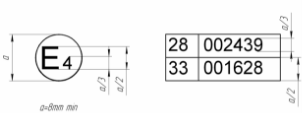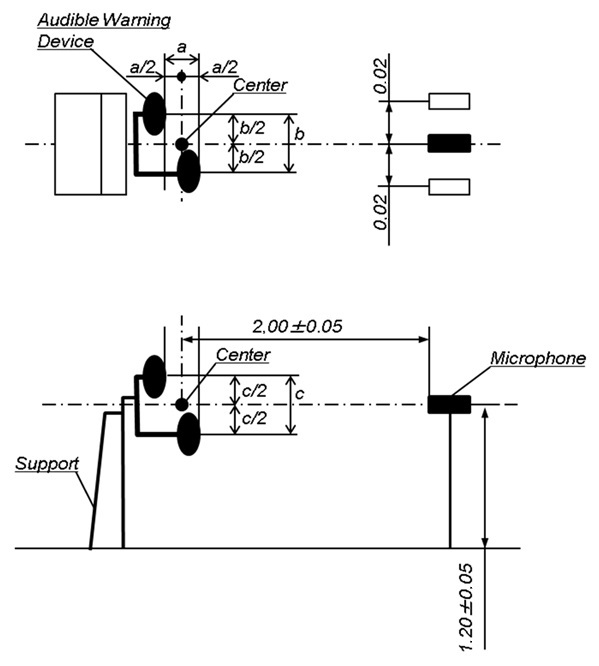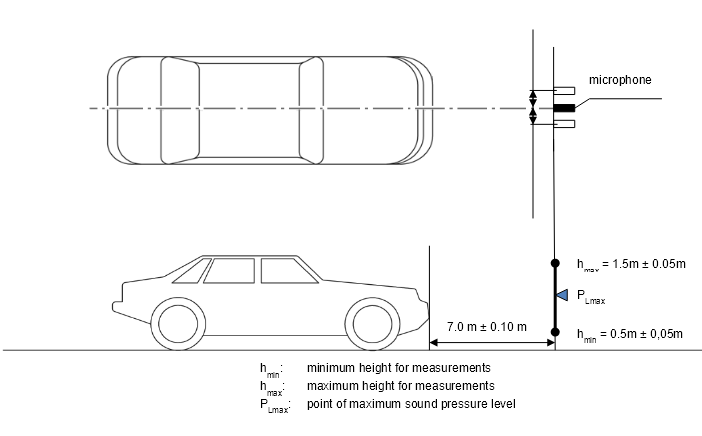1. Scope
1.1. This Regulation applies to:
1.1.1. PART I: Approval of audible warning device, audible warning system, multiple audible warning system supplied with direct or alternating current or compressed air, which are intended for fitting to motor vehicles of categories L3 to L5, M and N, excluding mopeds (categories L1 and L2);
1.1.2. PART II: Approval of motor vehicles listed in 1.1.1. with regard to fitting of devices specified under Part I.
I. Part I. Audible warning device, audible warning system, multiple audible warning system
2. Definitions
For the purpose of this Regulation:
2.1. "Audible warning device" means a device consisting of one or several sound emission outlets that are excited simultaneously, emitting an acoustic signal which is intended to give audible warning of the presence of a vehicle in a dangerous road traffic situation and which is intentionally operated by a driver;
2.2. "Audible warning system" means a combination of audible warning devices mounted on a common bracket operating simultaneously by the actuation of a single control;
2.3. "Multiple audible warning system" means a combination of audible warning devices capable of functioning independently;
2.4. Principles of operation of audible warning device, audible warning system, multiple audible warning system:
2.4.1. "Pneumatic" means a principle of operation by an external compressed air source;
2.4.2. "Electro-pneumatic" means a principle of operation by a compressed air source which is controlled by electrical supply (direct or alternating current);
2.4.3. "Electro-magnetic with resonator disc" means a principle of operation by electro-magnetic force amplified by resonator disc;
2.4.4. "Electro-magnetic with horn" means a principle of operation by electro-magnetic force amplified by a horn;
2.5. "Type of audible warning device (audible warning system, multiple audible warning system)" means audible warning devices (audible warning systems, multiple audible warning systems) not differing essentially from each other with respect to such matters as:
2.5.1. Trade name or mark;
2.5.2. Base designation:
2.5.2.1. For vehicles of categories L3 to L5 of a power less than or equal to 7 kW (class I);
2.5.2.2. For vehicles of categories M, N and L3 to L5 of a power greater than 7 kW (class II);
2.5.3. Principles of operation;
2.5.4. Audible warning devices, audible warning systems, multiple audible warning systems with electrical supply:
2.5.4.1. Type of electrical supply (direct or alternating current);
2.5.4.2. Shape and dimensions of diaphragm(s);
2.5.4.3. Rated voltage;
2.5.5. Audible warning devices, audible warning systems, multiple audible warning systems supplied directly from an external compressed air source:
2.5.5.1. Rated operating pressure;
2.5.6. Outer shape of a case;
2.5.7. Shape or kind of sound outlet(s);
2.5.8. Rated sound frequency or frequencies;
2.5.9. Shape and dimensions of rigid connections for audible warning system, multiple audible warning system.
3. Application for approval
3.1. The application for approval of a type of audible warning device, audible warning system, multiple audible warning system shall be submitted by its manufacturer or by his duly accredited representative.
3.2. It shall be accompanied by a duly filled technical information document, either in paper format in triplicate or alternatively upon agreement with the Type Approval Authority in electronic format. A model of the technical information document is shown in Annex 1A.
3.3. In addition, the application for approval shall be accompanied by two samples of the type of audible warning device, audible warning system, multiple audible warning system.
3.4. The Type Approval Authority shall verify the existence of satisfactory arrangements for ensuring effective control of the conformity of production before type approval is granted.
4. Markings
4.1. Audible warning devices and each sound emitting component of an audible warning system or multiple audible warning system excluding mounting accessories, shall bear:
4.1.1. The trade name or mark of the manufacturer and the model commercial name and/or number;
4.1.2. The approval mark according to paragraph 5.5.
4.2. The approval mark shall be shown on the audible warning device, audible warning system, multiple audible warning system according to paragraph 5.5. Each sample shall have a space of adequate dimensions for the approval mark; this space shall be indicated in the drawing.
4.3. All markings shall be clearly legible and indelible.
5. Approval
5.1. If the two samples submitted for approval conform to the provisions of paragraph 6. below, approval for this type of audible warning device, audible warning system, multiple audible warning system shall be granted.
5.2. An approval number shall be assigned to each type approved. Its first two digits (at present 00 for the UN Regulation in its original form) shall indicate the series of amendments incorporating the most recent major technical amendments made to the UN Regulation at the time of issue of the approval. The same Contracting Party may not assign this number to another type of audible warning device, audible warning system, multiple audible warning system.
5.3. The same approval number may be assigned to types of audible warning device, audible warning system, multiple audible warning system differing only with respect to rated voltage, rated sound frequency or frequencies or rated operating pressure.
5.4. Communication on approval or refusal or extension or withdrawal of approval or production definitely discontinued of a type of audible warning device, audible warning system, multiple audible warning system pursuant to this UN Regulation shall be communicated to the Parties to the Agreement applying this UN Regulation by means of a form conforming to the model in Annex 1A to the UN Regulation.
5.5. On every audible warning device, audible warning device, audible warning system, multiple audible warning system which conforms to a type approved under this Regulation, there shall be affixed conspicuously, in an easily accessible place indicated on the approval form, an international approval mark comprising:
5.5.1. A circle containing the letter "E" followed by the distinguishing number of the country granting approval;
5.5.2. An approval number;
5.5.3. An additional symbol in the form of a figure in Roman numerals, showing the class to which the audible warning device, audible warning system, multiple audible warning system belongs.
5.6. Annex 2, Section I, to this Regulation gives an example of the arrangement of the approval mark.
5.7. The Type Approval Authority or its duly accredited technical service shall verify the arrangements of the marks for ensuring effective control of the conformity of production before type approval is granted.
6. Specifications
6.1. General specifications
6.1.1. The audible warning device, audible warning system, multiple audible warning system shall emit a continuous and uniform sound; its acoustic spectrum shall not vary substantially during its operation.
For audible warning devices, audible warning system, multiple audible warning system supplied with alternating current, this requirement shall apply only at constant generator speed, within the range specified in paragraph 6.3.4.2.
The type approval tests shall be carried out on two samples of each type submitted by the manufacturer for approval; both the samples shall be subjected to all the tests and must conform to the technical specifications laid down.
6.1.2. The audible warning device, audible warning system, multiple audible warning system shall have acoustic characteristics (spectral distribution of the acoustic energy, sound pressure level) and mechanical characteristics such that it passes, in the order indicated, the tests according to paragraphs 6.3. and 6.4.
6.2. Measuring instruments
6.2.1. Acoustic measurements
6.2.1.1. When no general statement or conclusion can be made about conformance of the sound level meter model to the full specifications of IEC 61672-1:2013, the apparatus used for measuring the sound pressure level shall be a sound level meter or equivalent measurement system meeting the requirements of Class 1 instruments as described in IEC 61672-3:2013.3 Measurements shall be carried out using the "fast" response of the acoustic measurement instrument and the "A" weighting curve as described in IEC 61672-1:20133. When using a system that includes a periodic monitoring of the A-weighted sound pressure level, a reading should be made at a time interval not greater than 30 ms.
When measurements of the sound pressures in the one-third mid-band frequencies 2,000, 2,500 and 3,150 Hz are carried out for one-third octaves, the instrumentation shall meet all requirements of IEC 61260-1-2014, class 1. The sound pressure level in the mid-band frequency 2,500 Hz shall be determined by adding the quadratic means of the sound pressures in the one-third mid-band frequencies 2,000, 2,500 and 3,150 Hz.
When measuring the rated sound frequency (or frequencies), the digital sound recording system shall have at least a 16 bit quantization. The average auto power spectrum shall be determined, using a Hanning window and at least 66.6 per cent overlap averages.
The instruments shall be maintained and calibrated in accordance with the instructions of the instrument manufacturer.
6.2.1.2. Calibration of the entire Acoustic Measurement System for a Measurement Session
At the beginning and at the end of every measurement session the entire measurement system shall be checked by means of a sound calibrator that fulfils the requirements for sound calibrators of at least precision Class 1 according to IEC 60942:2003. Without any further adjustment the difference between the readings of two consecutive checks shall be less than or equal to 0.5 dB.
If this value is exceeded, the results of the measurements obtained after the previous satisfactory check shall be discarded.
6.2.1.3. Compliance with requirements
Compliance of the sound calibrator with the requirements of IEC 60942:2003 and compliance of the instrumentation system with the requirements of IEC 61672-3:20133 shall be confirmed by the existence of a valid certificate of compliance.
6.2.2. Instrumentation for other measurements
The voltage shall be measured with instrumentation having an accuracy of ±0.05 V or better.
The resistance shall be measured with instrumentation having an accuracy of ±0.01 Ω or better.
The distance shall be measured with instrumentation having an accuracy of ±5 mm or better.
The time shall be measured with instrumentation having an accuracy of ±0.02 s or better.
The meteorological instrumentation used to monitor the environmental conditions during the test shall include the following devices, which meet at least the following accuracy:
(a) Temperature measuring device, ±1° C;
(b) Wind speed-measuring device, ±1.0 m/s;
(c) Barometric pressure measuring device, ±5 hPa;
(d) A relative humidity measuring device, ±5 per cent.
6.3. Measurement of the sound characteristics.
6.3.1. The audible warning device, audible warning system, multiple audible warning system should, preferably, be tested in an anechoic chamber. Alternatively, it may be tested in a semi-anechoic chamber or in an open space. In these cases, precautions shall be taken to avoid reflections from the ground within the measuring area (for instance by erecting a set of absorbing screens). The wind speed shall be not more than 5 m/s. The ambient noise level shall be at least 10 dB lower than the sound pressure level to be measured.
If the test facility shall be qualified as an anechoic environment it shall meet requirements of Annex 3.
6.3.2. The audible warning device, audible warning system, multiple audible warning system to be tested and the microphone shall be placed at the same height. This height shall be 1.20 ± 0.05 m.
In alternative, the audible warning device, audible warning system, multiple audible warning system to be tested and the microphone may be placed in another traverse line which complies with Annex 3 specification for anechoic environment.
The microphone shall be so placed that its diaphragm is at a distance
of 2.00 ± 0.05 m from the plane of the sound outlet of the audible warning device, audible warning system, multiple audible warning system. The microphone must be positioned facing the front surface emitting sound of the audible warning device, audible warning system, multiple audible warning system in the direction in which the maximum sound level can be measured. (see figures in Annex 4).
In the case of audible warning device with several outlets, the distance shall be determined in relation to the plane of the nearest outlet to the microphone.
6.3.3. The audible warning device, audible warning system, multiple audible warning system shall be mounted rigidly, by means of the equipment indicated by the manufacturer, on a support whose mass is at least ten times that of the audible warning device, audible warning system, multiple audible warning system under test and not less than 30 kg. In addition, arrangements must be made ensuring that reflections on the sides of the support and its own vibrations have no appreciable effect on the measuring results.
6.3.4. The audible warning device, audible warning system, multiple audible warning system shall be supplied with current, as appropriate, at the following voltages:
6.3.4.1. In the case of audible warning device, audible warning system, multiple audible warning system supplied with direct current, at a voltage measured at the terminal of the electric power source of 13/12 of the rated voltage;
6.3.4.2. In the case of audible warning device, audible warning system, multiple audible warning system supplied with alternating current, the current shall be supplied by an electric generator of the type normally used with this type of audible warning device, audible warning system, multiple audible warning system. The acoustic characteristics of the audible warning device, audible warning system, multiple audible warning system shall be recorded for electric generator speeds corresponding to 50 per cent, 75 per cent and 100 per cent of the maximum speed indicated by the manufacturer of the generator for continuous operation. During this test, no other electrical load shall be imposed on the electric generator. The endurance test described in paragraph 6.4. shall be carried out at a speed indicated by the manufacturer of the equipment and selected from the above range.
6.3.5. If a rectified current source is used for the test of an audible warning device, audible warning system, multiple audible warning system supplied with direct current, the alternating component of the voltage measured at its terminals, when the warning devices are in operation, shall not be more than 0.1 V, peak to peak.
6.3.6. For audible warning device, audible warning system, multiple audible warning system supplied with direct current, the resistance of the connecting leads, expressed in ohms, including terminals and contacts, shall be as close as possible to (0,10/12) x rated voltage in volt.
6.3.7. Under the conditions set forth above, the sound-pressure level weighted in accordance with curve A shall not exceed the following values:
(a) 115 dB(A) for audible warning device, audible warning system, multiple audible warning system intended principally for vehicles of categories L3 to L5 with a power less than or equal to 7 kW;
(b) 118 dB(A) for audible warning device, audible warning system, multiple audible warning system intended principally for vehicles of categories M, N and L3 to L5 with a power greater than 7 kW.
6.3.7.1. In addition, the sound-pressure level in the frequency band 1,800 to 3,550 Hz shall be greater than that of any component of a frequency above 3,550 Hz and in any event equal to or greater than:
(a) 95 dB(A) for audible warning device, audible warning system, multiple audible warning system intended principally for vehicles of categories L3 to L5 with a power less than or equal to 7 kW;
(b) 105 dB(A) for audible warning device, audible warning system, multiple audible warning system intended principally for vehicles of categories M, N and L3 to L5 with a power greater than 7 kW.
6.3.7.2. Audible warning device, audible warning system, multiple audible warning system meeting the sound characteristics mentioned in (b) may be used on the vehicles mentioned in (a).
6.3.7.3. In the case of multiple audible warning systems, the minimum values of sound pressure level as specified in paragraph 6.3.7.1. shall be obtained when each of the constituent units is operated separately. The maximum values of the sound pressure level as specified in paragraph 6.3.7. shall not be exceeded when all the constituent units are operated simultaneously.
6.3.8. The specifications indicated above shall also be met by an audible warning device, audible warning system, multiple audible warning system subjected to the endurance test referred to in paragraph 6.4. below, with the supply voltage varying between 115 per cent and 95 per cent of its rated voltage for audible warning device, audible warning system, multiple audible warning system supplied with direct current or, for audible warning device, audible warning system, multiple audible warning system supplied with alternating current, between 50 per cent and 100 per cent of the maximum speed of the generator indicated by the manufacturer for continuous operation.
6.3.9. The time lapse between the moment when the audible warning device, audible warning system, multiple audible warning system is actuated and the moment when the sound reaches the minimum value prescribed in paragraph 6.3.7.1. above shall not exceed 0.2 second measured at an ambient temperature of 20 + 5 ºC. This provision is applicable inter alia, to pneumatic or electro-pneumatic audible warning device, audible warning system, multiple audible warning system.
6.3.10. Pneumatic or electro-pneumatic audible warning device, audible warning system, multiple audible warning system shall, when operating under the power supply conditions established by the manufacturers, satisfy the same acoustic requirements as are prescribed for electrically operated audible warning device, audible warning system, multiple audible warning system.
6.3.11. To confirm the rated sound frequency (or frequencies) of audible warning device, audible warning system, multiple audible warning system the tests to measure this parameter using a spectrum analyzer with a frequency resolution of at least 1 Hz shall be conducted. The measured frequency (or frequencies) of the audible warning device, audible warning system, multiple audible warning system may differ from the rated sound frequency (or frequencies) no more than 10 per cent.
6.4. Endurance test
6.4.1. The audible warning device, audible warning system, multiple audible warning system shall be supplied with current at the rated voltage and with the connecting lead resistances specified in paragraphs 6.3.4. to 6.3.6. above, and operated respectively:
10,000 times for audible warning device, audible warning system, multiple audible warning system intended principally for vehicles of categories L3 to L5 with a power less than or equal to 7 kW.
50,000 times for audible warning device, audible warning system, multiple audible warning system intended principally for vehicles of categories M, N and L3 to L5 with a power greater than 7 kW, each time for one second followed by an interval of 4 s.
During the test, the audible warning device, audible warning system, multiple audible warning system shall be ventilated by an air current having a speed of approximately 10 m/s and the electro-pneumatic audible warning device, audible warning system, multiple audible warning system may be lubricated with the oil recommended by the manufacturer after every 10,000 times of operation.
6.4.2. If the test is made in an anechoic chamber, the chamber shall be large enough to ensure normal dispersal of the heat released by the audible warning device, audible warning system, multiple audible warning system during the test.
6.4.3. The ambient temperature in the testing room shall be between +15 and +30 ºC inclusively.
6.4.4. If, after the audible warning device, audible warning system, multiple audible warning system has been operated for half the number of times prescribed, the sound-level characteristics are no longer the same as before the test, the audible warning device, audible warning system, multiple audible warning system may be adjusted. After being operated the prescribed number of times, and after further adjustment if necessary, the audible warning device, audible warning system, multiple audible warning system must pass the test described in paragraph 6.3. above.
7. Modification and extension of approval of the type of the audible warning device, audible warning system, multiple audible warning system
7.1. Every modification of the type of the audible warning device, audible warning system, multiple audible warning system shall be notified to the Type Approval Authority which granted approval to that type of the audible warning device, audible warning system, multiple audible warning system. This Type Approval Authority may then:
7.1.1. Either take the view that the modifications made are not likely to have any appreciable adverse effect;
7.1.2. Or call for a new report from the Technical Service responsible for the tests.
7.2. Communication on confirmation of the approval, with particulars of the modifications, or of refusal of approval shall be communicated to the Parties to the Agreement applying this Regulation, in accordance with the procedure indicated in paragraph 5.4. above.
7.3. The Type Approval Authority issuing the extension of approval shall assign a series number to each communication form drawn up for such an extension.
8. Conformity of production
The conformity of production procedures shall comply with those set out in the 1958 Agreement, Schedule 1 (E/ECE/TRANS/505/Rev.3) with the following requirements:
8.1. Audible warning device, audible warning system, multiple audible warning system approved under this Regulation shall be so manufactured as to conform to the type approved by meeting the requirements set forth in paragraph 6. above.
8.2. The authority which has granted type approval may at any time verify the conformity control methods applied in each production facility. The normal frequency of these verifications shall be once every two years.
9. Penalties for non-conformity of production
9.1. The approval granted to a type of audible warning device, audible warning system, multiple audible warning system pursuant to this Regulation may be withdrawn if the conditions set forth in paragraph 8.1. are not complied with or if the audible warning device, audible warning system, multiple audible warning system fails to pass the checks referred to in paragraph 8.2. above.
9.2. Should a Party to the Agreement applying this Regulation withdraw an approval which it has previously granted, it shall forthwith notify the other Contracting Parties applying this Regulation by means of a copy of the approval form bearing at the end in large letters the statement, signed and dated: "APPROVAL WITHDRAWN".
10. Production definitively discontinued
If the holder of an approval granted pursuant to this Regulation discontinues the production of the type of audible warning device, audible warning system, multiple audible warning system approved, he shall inform the authority which granted the approval. Upon receipt of the communication, this authority shall inform the other Parties to the Agreement applying this Regulation by means of a copy of the approval form bearing at the end in large letters the statement, signed and dated: "PRODUCTION DISCONTINUED".
II. Part II. Audible warning signals of motor vehicles
11. Definitions
For the purpose of this Regulation,
11.1. "Approval of the motor vehicle" shall be understood to mean approval of a vehicle type with regard to its audible warning signal;
11.2. "Vehicle type" shall be understood to mean vehicles not essentially different from another with respect to such matters as:
11.2.1. The number and type(s) of audible warning devices and/or audible warning systems and/or multiple audible warning systems fitted on the vehicle;
11.2.2. The mountings used to fit the audible warning device(s) and/or audible warning system(s) and/or multiple audible warning system(s) to the vehicle;
11.2.3. The position of the audible warning device(s) and/or audible warning system(s) and/or multiple audible warning system(s) on the vehicle;
11.2.4. The rigidity of the parts of the structure on which the audible warning device(s) and/or audible warning system(s) and/or multiple audible warning system(s) is (are) mounted;
11.2.5. The shape and materials of the bodywork at the front of the vehicle which might affect the level of the sound emitted by the audible warning device(s) and/or audible warning system(s) and/or multiple audible warning system(s) and have a masking effect.
12. Application for approval
12.1. The application for approval of a vehicle type with regard to its audible warning signals shall be submitted by the vehicle manufacturer or by his duly accredited representative;
12.2. It shall be accompanied by a duly filled technical information document, either in paper format in triplicate or alternatively upon agreement with the Type Approval Authority in electronic format. A model of the technical information document is shown in Annex 1B.
12.3. A vehicle representative of the vehicle type to be approved shall be submitted to the technical service responsible for the approval tests.
13. Approval
13.1. If the vehicle type submitted for approval pursuant to this Regulation meets the requirements of paragraph 14. below, approval for this vehicle type shall be granted.
13.2. An approval number shall be assigned to each type approved. Its first two digits (at present 00 for the UN Regulation in its original form) shall indicate the series of amendments incorporating the most recent major technical amendments made to the UN Regulation at the time of issue of the approval. The same Contracting Party may not assign this number to another vehicle type.
13.3. Communication on approval or extension or withdrawal of approval or production definitely discontinued of a vehicle type pursuant to this Regulation shall be communicated to the Parties to the Agreement applying this Regulation by means of a form conforming to the model in Annex 1B to the UN Regulation.
13.4. On every vehicle which conforms to a vehicle type approved under this Regulation there shall be affixed conspicuously, in an easily accessible place indicated on the approval form, an international approval mark comprising:
13.4.1. A circle surrounding the letter "E" followed by the distinguishing number of the country which has granted approval;
13.4.2. The number of this Regulation, followed by the letter "R", a dash and the approval number placed to the right of the circle prescribed in paragraph 13.4.1.
13.5. If the vehicle conforms to a vehicle type approved, under one or more other Regulations annexed to the Agreement, in the country which has granted approval under this Regulation, the symbol prescribed in paragraph 13.4.2. need not be repeated; in such a case the UN Regulation and approval numbers and the additional symbols of all the UN Regulations under which approval has been granted in the country which has granted approval under this Regulation shall be placed in vertical columns to the right of the symbol prescribed in paragraph 13.4.
13.6. The approval mark must be clearly legible and indelible.
13.7. The approval mark shall be placed near the plate bearing the characteristics of the vehicle and may also be affixed to this plate.
13.8. Annex 2, Section II, to this Regulation gives an example of the arrangement of the approval mark.
13.9. The Type Approval Authority shall verify the existence of satisfactory arrangements for ensuring effective control of the conformity of production before type approval is granted.
14. Specifications
14.1. General specifications
14.1.1. The audible warning device, audible warning system, multiple audible warning system shall be so designed, constructed and assembled as to enable the vehicle, in normal use, despite the vibration to which it may be subjected, to comply with the provisions of this Regulation.
14.1.2. The audible warning device(s), audible warning system(s), multiple audible warning system(s) and its (their) mounting elements to the vehicle shall be so designed, constructed and assembled as to be able to reasonably resist the corrosive phenomena to which it is exposed with regards to the conditions of use of the vehicle, including regional climate differences.
14.2. Specifications regarding sound levels
14.2.1. The sound made by the audible warning device(s), audible warning system(s), multiple audible warning system(s) fitted to the vehicle type submitted for approval shall be measured by the methods described in paragraph 14.3.;
14.2.2. Measured under the conditions specified in paragraphs 14.3. the sound-pressure level of the audible warning signal tested shall be at least:
(a) Equal to 83 dB (A) and not more than 112 dB (A) for the signals of vehicles of categories L3 to L5 of a power less than or equal to 7 kW;
(b) Equal to 87 dB (A) and at most 112 dB (A) for the signals of vehicles of categories M, N and L3 to L5 of a power greater than 7 kW.
14.2.3. The values measured in accordance with the provisions of paragraph 14.3 shall be entered in the test report and a communication corresponding to the model shown in Annex 1B.
14.3. Methods of measurement on stationary vehicle
14.3.1. The vehicle shall comply with the following specifications:
14.3.1.1. The audible warning device(s), audible warning system(s), multiple audible warning system(s) fitted on the vehicle shall be of a type approved under this Regulation (Part I);
Audible warning devices of Class II approved under this Regulation in its original form, and therefore not bearing the symbol II in their approval mark, may continue to be fitted to vehicle types submitted for approval pursuant to this Regulation.
14.3.1.2. The test voltage shall be as specified in paragraph 6.3.4. of the UN Regulation;
In case of audible warning device(s), audible warning system(s), multiple audible warning system(s) supplied with direct current, the test voltage shall be supplied by either:
(a) The vehicle battery only; or
(b) The vehicle battery with the vehicle engine warmed-up and at idle; or
(c) With an external power source supply connected to the audible warning device(s), audible warning system(s), multiple audible warning system(s).
14.3.2. The sound pressure level and other measurements shall be made according to the conditions specified in paragraph 6.2. of this Regulation.
14.3.3. The A-weighted sound pressure level emitted by the audible warning device(s), audible warning system(s), multiple audible warning system(s) fitted on the vehicle shall be measured at a distance of 7.00 ± 0.10 m in front of the vehicle (see figures in Annex 5), which is being placed on an open site, on flat concrete or asphalt surface.
14.3.4. The microphone of the measuring instrument shall be placed approximately (± 0.10 m) in the mean longitudinal plane of the vehicle;
14.3.5. Background noise and wind noise must be at least 10 dB (A) below the sound to be measured;
14.3.6. The maximum sound-pressure level shall be sought within the range of 0.5 and 1.5 m above the ground, and the height, at which the maximum sound-pressure level was found has to be fixed for the purpose of taking the measurements prescribed below.
The sound pressure level shall be measured at that fixed height for a duration of at least 3 seconds. The final result shall be the maximum A-weighted sound pressure level of the reading period, rounded mathematically to the nearest integer.
15. Modification and extension of approval of the vehicle type
15.1. Every modification of the vehicle type shall be notified to the Type Approval Authority which granted approval to the vehicle type. This Type Approval Authority may then:
15.1.1. Either take the view that the modifications made are not likely to have any appreciable adverse effect and that in any case the vehicle still meets the requirements; or
15.1.2. Call for a new report from the Technical Service responsible for the tests.
15.2. Communication on confirmation of approval with particulars of the modifications, or of refusal of approval shall be communicated to the Parties to the Agreement applying this Regulation, in accordance with the procedure indicated in paragraph 13.3. above.
15.3. The Type Approval Authority issuing the extension of approval shall assign a series number to each communication form drawn up for such an extension.
16. Conformity of production
The conformity of production procedures shall comply with those set out in the 1958 Agreement, Schedule 1 (ECE/TRANS/505/Rev.3) with the following requirements:
16.1. A vehicle approved under this Regulation shall be so manufactured as to conform to the type approved by meeting the requirements set forth in paragraph 14. above.
16.2. The Type Approval Authority which has granted type approval may at any time verify the conformity control methods applied in each production facility. The normal frequency of these verifications shall be once every two years.
17. Penalties for non-conformity of production
17.1. The approval granted to a vehicle type pursuant to this Regulation may be withdrawn if the conditions set forth in paragraph 16.1. above are not complied with, or if the vehicle fails to pass the checks referred to in paragraph 16.2. above.
17.2. Should a Party to the Agreement applying this Regulation withdraw an approval which it has previously granted, it shall forthwith notify the other Contracting Parties applying this Regulation by means of a copy of the approval from bearing at the end in large letters the statement, signed and dated: "APPROVAL WITHDRAWN".
18. Production definitively discontinued
18.1. If the holder of the approval completely ceases to manufacture a vehicle type approved in accordance with this Regulation, he shall so inform the authority which granted the approval. Upon receiving the relevant communication that authority shall inform thereof the other Parties to the 1958 Agreement applying this Regulation by means of a communication form conforming to the model in Annex 1B to this Regulation.
19. Names and addresses of Technical Services responsible for conducting approval tests and of Type Approval Authorities
The Contracting Parties to the 1958 Agreement applying this Regulation shall communicate to the United Nations Secretariat the names and addresses of the Technical Services responsible for conducting approval tests and of the Type Approval Authorities which grant approval and to which forms certifying approval or extension or refusal or withdrawal of approval, issued in other countries, are to be sent.









